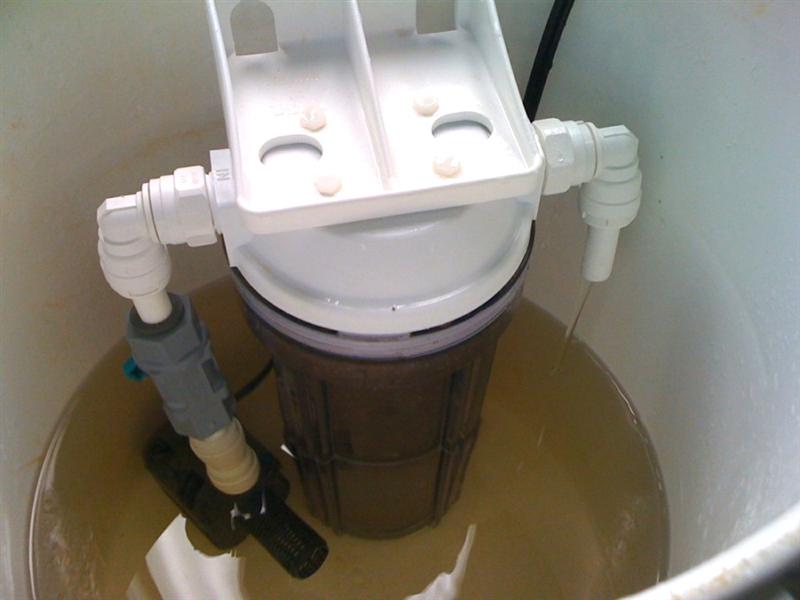Navigation
Install the app
How to install the app on iOS
Follow along with the video below to see how to install our site as a web app on your home screen.
Note: This feature may not be available in some browsers.
More options
You are using an out of date browser. It may not display this or other websites correctly.
You should upgrade or use an alternative browser.
You should upgrade or use an alternative browser.
Recharging GAC and GFO
- Thread starter peachyman
- Start date
- Tagged users None
Phosphates that don't register on the salifert. I'll eventually get a more sensitive tester.What parameters are you looking at for gac?
Randy Holmes-Farley
Reef Chemist
View Badges
Staff member
Super Moderator
Excellence Award
Expert Contributor
Article Contributor
R2R Research
My Tank Thread
- Joined
- Sep 5, 2014
- Messages
- 67,347
- Reaction score
- 63,689
The peroxide will not impact phosphate bound to GFO. It may remove organic matter from it, and to the extent that organic matter is blocking additional phosphate uptake, it may help (or not) with GFO.
I do not know how effective it is at removing organics from GAC to allow additional organic binding, but it might be.
I do not know how effective it is at removing organics from GAC to allow additional organic binding, but it might be.
Randy Holmes-Farley
Reef Chemist
View Badges
Staff member
Super Moderator
Excellence Award
Expert Contributor
Article Contributor
R2R Research
My Tank Thread
- Joined
- Sep 5, 2014
- Messages
- 67,347
- Reaction score
- 63,689
Is possible to regenerate with a caustic - NaOH for example, in theory, anyone ever do this?
GFO? Yes, it appears that can be partly recharged with base and folks have posted methods.

Aquarium Chemistry: Regeneration of Granular Ferric Oxide Media with Sodium Hydroxide
For aquarists who keep non-photosynthetic corals that require massive feeding, have large tanks, or a dense fish population the costs of regular GFO replacement can be significant. With a few simple tools and techniques we can easily regenerate GFO so that it can be reused several times over.
redfishbluefish
Stay Positive, Stay Productive
View Badges
Staff member
Super Moderator
Reef Squad
Partner Member 2024
Excellence Award
Article Contributor
NJRC Member
Hospitality Award
My Tank Thread
Back in my day (I'm a dinosaur of a chemist) the only way to regenerate GAC was in a blast furnace.
- Joined
- Jan 15, 2020
- Messages
- 1,520
- Reaction score
- 1,511
500° C is not going to be enough, is it?Back in my day (I'm a dinosaur of a chemist) the only way to regenerate GAC was in a blast furnace.
redfishbluefish
Stay Positive, Stay Productive
View Badges
Staff member
Super Moderator
Reef Squad
Partner Member 2024
Excellence Award
Article Contributor
NJRC Member
Hospitality Award
My Tank Thread
500° C is not going to be enough, is it?
Just looked it up...."The material is heated up to around 1000º F, which volatilizes 75 – 90% of the adsorbed materials. At this point, steam is injected into the system to remove the remaining volatiles and “reactivate” the carbon."
Randy Holmes-Farley
Reef Chemist
View Badges
Staff member
Super Moderator
Excellence Award
Expert Contributor
Article Contributor
R2R Research
My Tank Thread
- Joined
- Sep 5, 2014
- Messages
- 67,347
- Reaction score
- 63,689
500° C is not going to be enough, is it?
One of the concerns is that if you heat it high enough to burn off organics, you may burn the GAC itself unless you do it in a low O2 environment.

The Care and Handling of Activated Carbon
By Kenneth E. Schaeffer Activated carbon adsorbent media is easy to use and easy to handle. If stored properly, it has an indefinite shelf life. It is nontoxic and relatively nonflammable. If it has become wet or damaged through improper storage, it usually can be dried out or restored easily. Af
wcponline.com
Activated carbon is combustible, but not easily ignited. In the absence of a forced draft, even hot activated carbon supports combustion with difficulty and, under some conditions, will extinguish on its own accord. However, it should not be subjected to a blast of air at temperatures above approximately 400°F.
- Joined
- Jan 15, 2020
- Messages
- 1,520
- Reaction score
- 1,511
Huh, a self cleaning oven might almost achieve that. The superheated steam would be a bit risky thoughJust looked it up...."The material is heated up to around 1000º F, which volatilizes 75 – 90% of the adsorbed materials. At this point, steam is injected into the system to remove the remaining volatiles and “reactivate” the carbon."
Randy Holmes-Farley
Reef Chemist
View Badges
Staff member
Super Moderator
Excellence Award
Expert Contributor
Article Contributor
R2R Research
My Tank Thread
- Joined
- Sep 5, 2014
- Messages
- 67,347
- Reaction score
- 63,689
Huh, a self cleaning oven might almost achieve that. The superheated steam would be a bit risky though
Try it on a few grains and see if they are still there after the cleaning.
- Joined
- Jan 15, 2020
- Messages
- 1,520
- Reaction score
- 1,511
I was about to but then it occured to me that it's probably not such a great idea. Wikipedia says palytoxin decomposes at 300° C but I don't particularly want to find out what happens while heating up to that pointTry it on a few grains and see if they are still there after the cleaning.
Randy Holmes-Farley
Reef Chemist
View Badges
Staff member
Super Moderator
Excellence Award
Expert Contributor
Article Contributor
R2R Research
My Tank Thread
- Joined
- Sep 5, 2014
- Messages
- 67,347
- Reaction score
- 63,689
I was about to but then it occured to me that it's probably not such a great idea. Wikipedia says palytoxin decomposes at 300° C but I don't particularly want to find out what happens while heating up to that point
I was thinking a new grain from the bottle, but I agree, even if it worked, you probably do not want to.
- Joined
- Jan 15, 2020
- Messages
- 1,520
- Reaction score
- 1,511
Sure but I wouldn't be comfortable using the results even if it turned out to workI was thinking a new grain from the bottle.
But I'll report back the next time I'll use the cleaning function
- Joined
- May 22, 2016
- Messages
- 6,545
- Reaction score
- 10,102
heh. this is one where the fact that GAC is so cheap really weighs against how I imagine this going.Huh, a self cleaning oven might almost achieve that. The superheated steam would be a bit risky though
I think if I volatilize a bunch of aquarium organics in the oven in my kitchen, then it would probably result in bad smells and bad moods. Both of which might linger for an unpleasantly long time.
Randy Holmes-Farley
Reef Chemist
View Badges
Staff member
Super Moderator
Excellence Award
Expert Contributor
Article Contributor
R2R Research
My Tank Thread
- Joined
- Sep 5, 2014
- Messages
- 67,347
- Reaction score
- 63,689
heh. this is one where the fact that GAC is so cheap really weighs against how I imagine this going.
I think if I volatilize a bunch of aquarium organics in the oven in my kitchen, then it would probably result in bad smells and bad moods. Both of which might linger for an unpleasantly long time.
lol
Similar threads
- Replies
- 35
- Views
- 836
- Replies
- 1
- Views
- 218
- Replies
- 10
- Views
- 311
- Replies
- 11
- Views
- 1,296

















